Śrī Patrikā Online 1.1 – Śrī Madhvācārya Special Edition

Kṛṣṇa-pakṣa, Vijaya-Daśamī, Padmanābha-māsa – October 5th, 2022 – On the auspicious occasion of Śrī Rāma-vijayotsava and Śrī Madhvācārya's Appearance
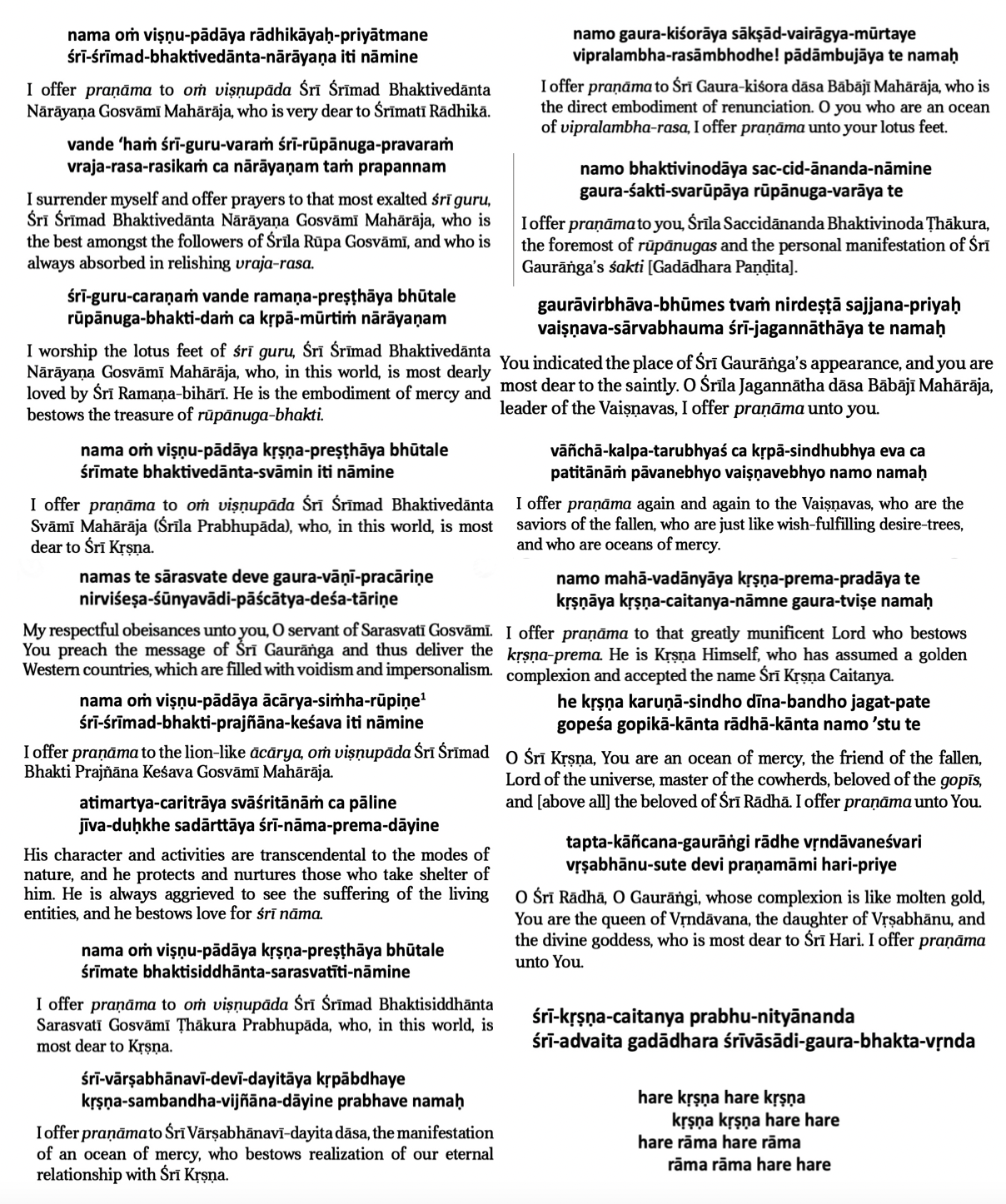
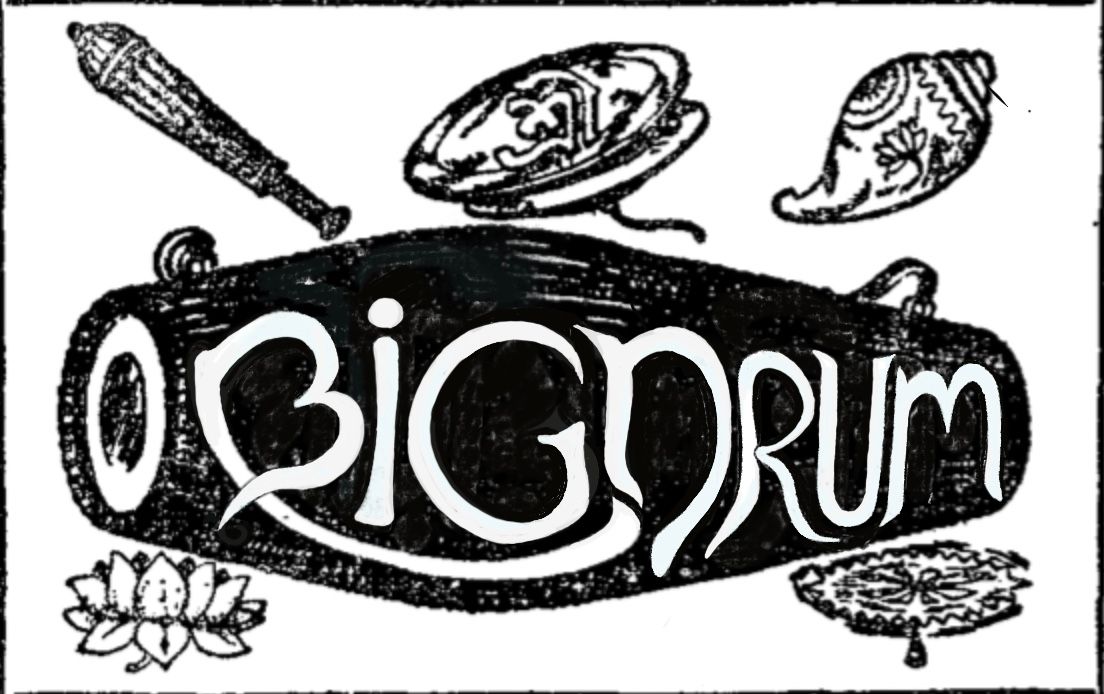
In honor of Saccidānanda Ṭhākura Śrī Bhaktivinoda’s Sajjana-toṣaṇī, Śrīla Bhaktisiddhānta Sarasavatī Ṭhākura Prabhupāda’s bṛhat-mṛdaṅga movement, which included the weekly Gauḍīya, The Harmonist, and numerous other publications, as well as the Back to Godhead magazines of Śrīla A.C. Bhaktivedānta Svāmī Prabhupāda, and the Śrī Gauḍīya- and Bhāgavata-Patrikās and The Rays of the Harmonist published under the guidance of Śrī Śrīmad Bhakti-Prajñāna Keśava Gosvāmī Mahārāja and his successors Śrī Śrīmad Bhaktivedānta Vāmana Gosvāmī Mahārāja and Śrī Śrīmad Bhaktivedānta Nārāyaṇa Gosvāmī Mahārāja, this “Śrī Patrikā” (by Big Drum) humbly seeks to serve out but particles and drops of the veritable ocean of sublime teachings bequeathed to us by the great Gauḍīya Vaiṣṇava luminaries of the past century.
“Śrī Patrikā”
[śrī – beauty; patrikā – magazine]
Translated from the first issue of Śrī Bhāgavata Patrikā, published June 5, 1955. Śrī Śrīmad Bhaktivedānta Nārāyaṇa Gosvāmī Mahārāja writes:
“The village gossip, or any manner of discourse that simply reiterates our meaningless materialistic preoccupation with eating, sleeping, mating, and defending, will find no place in “Śrī Patrikā”. All poetry, philosophy, and prose that condones indulgent gratification of the senses cannot come under the title “Śrī Patrikā”. Hence, ideas that are vi-śrī (without śrī) are not worthy of our honor. In other words, “Śrī” is the one and only supreme truth. We will check this modern world’s onslaught of beauty-less ideas and instead distribute the message that is replete with beauty (śrī-sampanna-vāṇī) as it descends from the transcendental realm of Vaikuṇṭha.”
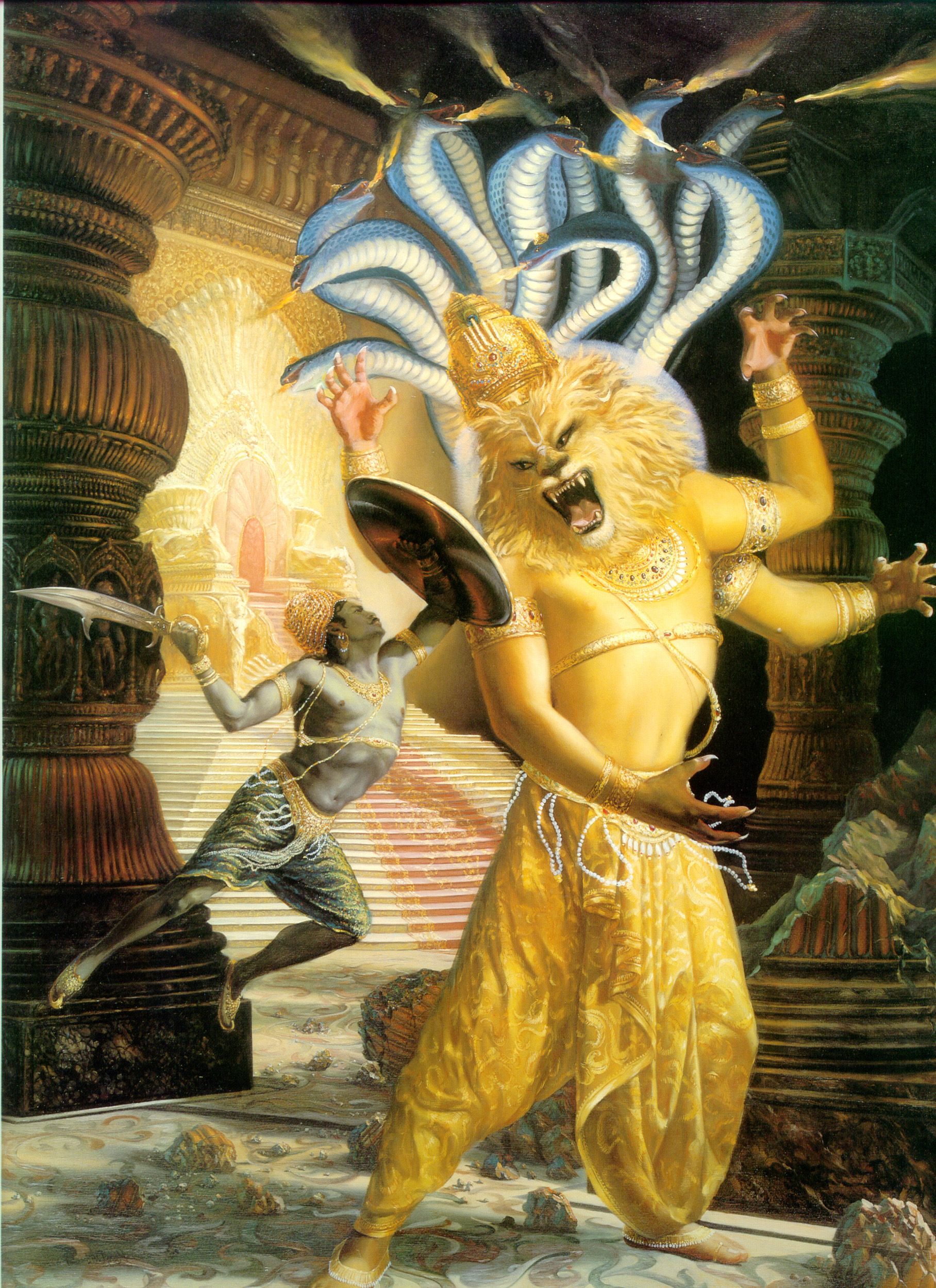
1. || śrī nṛsiṁha-nakha-stutīḥ ||
Hymn to Śrī Nṛsiṁha’s Nails
By Śrīman Madhvācārya
Legend has it that Śrī Madhvācārya would perform his daily worship privately and ask his disciples to wait elsewhere until he was finished. One day, Śrī Trivikrama Paṇḍitācārya (a former Śaṅkaraite ācārya), was so overcome with curiosity that he made a small hole in the wall of the temple to look through. What he saw within stunned him into total awe: Śrī Madhvācārya was performing his worship in three different forms at once! As Śrī Hanumān, he was serving Śrī Rāmacandra, as Śrī Bhīmasena, he was serving Śrī Vāsudeva Kṛṣṇa, and as Śrī Madhvā, he was worshipping Śrī Vyāsadeva. Tears of wonder rolling down his face, Trivikrama Paṇḍitācārya began to compose the forty-one verses of his famous Vāyu-stutī then and there. The omniscient Śrī Madhvācārya thereafter blessed his dear disciple with the following two verses in praise of Śrī Narasiṁha-deva’s nails and ordered him to recite them at the beginnning and end of his Vāyu-stutī.
पान्त्वस्मान् पुरुहुत वैरि बलवन मातङ्ग माद्यद्घटा
कुंभोच्चाद्रिविपाटनाऽधिकपटु प्रत्येक वज्रायिताः |
श्रीमत्कण्ठीरवास्य प्रतत सुनखरा दारिताराऽतिदूर
प्रद्ध्वस्त ध्वांत शांत प्रवितत मनसा भाविता भूरि-भागैः || १ ||
pāntvasmān puruhūta vairi balavan mātaṅga mādyad-ghaṭā kumbhoccādri-vipāṭanā ’dhika-paṭu pratyeka vajrāyitāḥ |
śrīmat-kaṇṭhīravāsya-pratata-sunakharā dāritārā’tidūra |
pradhvasta dhvānta śānta pravitata manasā bhāvitā bhūri-bhāgaiḥ || 1 ||
pāntu - protect; asmān - us; puruhūta - Indra; vairi - enemies; balavan - formidable; mātaṅga - elephants; mādyad - intoxicated; ghaṭā - a troop of elephants assembled for military purposes; kumbho - the frontal globes or prominence of an elephant’s upper forehead which swell during rutting season; ucca - high; adri - mountain; vipāṭana - to split into two; adhika - more; paṭu - skilled; prati - every; eka - one; vajrāyitāḥ - like thunderbolts; śrīmat - accompanied by Śrī (Lakṣmī-devī); kaṇṭhīrava - lion, lion’s roar; āsya - face, jaws; pratata - spread throughout; su - beautiful, complete, worshipful; nakharā - nails; dārita - torn; arā - an awl (a small pointed tool used to pierce holes in leather); atidūra - very far apart; pradhvasta - annihilated; dhvānta - a roaring wind, darkness; śānta - peace; pravitata - spread out, dishevelled; manasā - mind; bhāvitā - the state of being, predestination; bhūri - abundant, numerous; bhāgaiḥ - portions.
Protect us from the formidable enemies of Indra who are like intoxicated elephants in martial formation. However, each and every one of Your nails is like a thunderbolt and extremely well-adapted to tearing apart the tall mountain-like mounds of their heads. The roar and jaws of Thy beautiful lion-face are spread wide as Your perfect nails pierce and tear the demon’s apart like an leatherworker’s awl, scattering them across great distances. Thus You annihilate the howling darkness and pacify the dishevelled state of our minds by that numerous array [of nails].
[Note 1: Alternative reading: nakha-vṛndaiḥ, “the multitude of His nails”. Also, Śrī Madhvācārya displays noteworthy poetic skill in his composition here by combining two vṛtta-chandas (syllabic metres) in one verse. To construct even a single intelligible composition in one prescribed metre is no small feat, as each of the four lines must contain a specific number of syllables and make sense, let alone be poetic and philosophically profound. In the first half of these verses, he uses the Śārdūla-vikrīḍita metre, which means “that which is made a tiger or lion’s plaything”. In the second half, he uses Sragdharā, which means “that which wears a garland”. Thus the chandas express both the playful pacing of Śrī Narasiṁhadeva’s tussle with His elephantine prey and the shocking, gruesome finale of said prey’s intestines draped about His neck.]
लक्ष्मीकान्त समन्ततोऽपिकलयन नैवेशितुः ते समम् |
पश्याम्युत्तमवस्तु दूरतरतोऽपास्तं रसो योऽष्टमः|
यद्रोषोत्कर दक्षनेत्रकुटिलः प्रान्तोत्थिताऽग्नि स्फुरत |
खद्योतोपम विस्फुलिङ्ग भसिता ब्रह्मेश शक्रोत्कराः || २ ||
lakṣmī-kānta samantato ’pi kalayan naiveśituḥ te samam |
paśyāmy-uttama-vastu dūra-tarato ’pāstaṁ raso yo ’ṣṭamaḥ |
yad-roṣotkara dakṣa-netra-kuṭilaḥ-prāntotthitā ’gni sphurat |
khadyotopama-visphuliṅga bhasitā brahmeśa-śakrotkarāḥ || 2 ||
lakṣmī - Goddess of Fortune; kānta - beloved; samantatas - on all sides; api - unto; kalayan - perform; na - not; iva - like; īśituḥ - master; te - that; samam - equal; paśyāmi - I see; uttama - topmost; vastu - entity, object; dūratarataḥ - of a great distance; āpāstaṁ - thrown off; rasaḥ - mellow, flavor; yaḥ - from which; aṣṭamaḥ - eighth; yad - who; roṣotkara - rising anger; dakṣa-netra-kuṭilaḥ - Your third eye; kuṭilaḥ - crooked, curved; prānta - corner; utthitā - arising; agni - fire; sphurat – burst forth; khadyota - fireflies; upama - resemblance; visphuliṅga - sparks; bhasitā - consumed, burnt to ash; brahmeśa - Brahmā and Śiva; śakrotkarāḥ - Indra and his hosts of demigods.
O beloved of Lakṣmī Devī, though I have made a thorough study of all the scriptures, I see no one who is equal to You as master and granter of boons. You by far surpass the best of all that exists, which makes You the eighth rasa. Many multitudes of Brahmās, Śivas, Indras and their entourages are reduced to ash by the sparks of fire resembling glittering fireflies issuing from the curved edge of the rising mass of wrath that is Your right (or third) eye.
[Note 2: There are only six rasas, or flavors, namely: sweet, salty, sour, spicy, bitter, and astringent. There is no seventh rasa. So an eighth is simply beyond human comprehension, which aptly describes the position of Bhagavān. Another interpretation of this can be traced to the Chāndogya Upaniṣad (1.1.2): “The essence of all beings is the Earth (first rasa), the essence of Earth is water (second rasa), the essence of water is plants (third rasa), the essence of plants is man (fourth rasa), the essence of man is speech (fifth rasa), the essence of speech is the Ṛg Veda (sixth rasa), the essence of the Ṛg Veda is the Sāma Veda (seventh rasa), and the essence of the Sāma Veda is the udgītha or praṇava (oṁkāra, or Śrī Hari Himself, the eighth rasa).”]
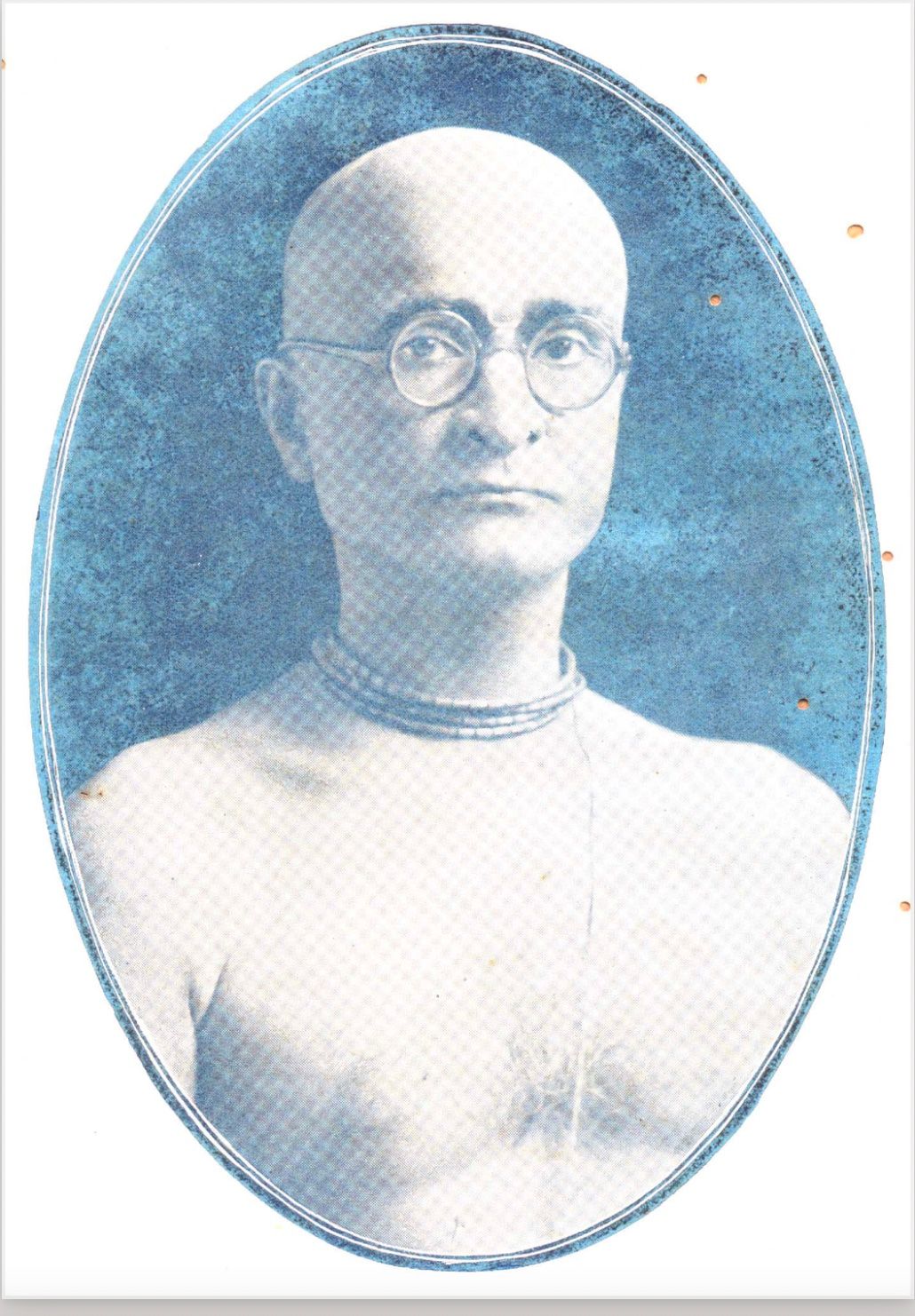
2. Prāṇanātha
“Lord of our Life Airs”
In Sajjana-toṣaṇī, 18.1 (March, 1915), Prabhupāda Śrī Śrīmad Bhaktisiddhānta Sarasvatī Ṭhākura Gosvāmī glorifies Śrī Pūrṇa-prajña Madhvācārya-pāda:
“In Śrī Brahma-vaivartta Purāṇa, in the fourth chapter of Śrī Kṛṣṇa-janma-khaṇḍa, we see that Vaikuṇṭha-dhāma and Goloka-dhāma are both eternally sheltered and held up by Vāyu, the god of wind. In Devī-dhāma (this world, the Goddess Durgā’s realm) there is a Vāyu referred to as a Maruta-deva, whereas in Vaikuṇṭha, it is the orignal Vāyudeva himself who is eternally engaged is the service of holding up Vaikuṇṭha. Needless to say, the material element of wind, or the Marud-deva of Deva-loka, is not comparable to Vaikuṇṭha’s transcendental Vāyudeva:
vaikuṇṭhaṁ paramaṁ dhāma jarā-mṛtyu-haraṁ param|
vāyunā dhāryamāṇañca brahmāṇḍād-urddhvam-uttamam||
na varṇanīyaṁ kavibhir-vicitraṁ ratna-nirmmitam |
[Vaikuṇṭha is the supreme abode; it is supreme for it eradicates old age and death. Vāyu, the god of Wind, holds up this highest point above the material universes. That place is indescribable, even by poets, an abode wondrously made of jewels.]
“Goloka-viṣaye urddhvam vaikuṇṭho ’gamyaṁ evaṁ vāyunā dhāryamāṇañca nirmmitam svecchayā vibhoḥ - As for Goloka, which is higher than Vaikuṇṭha, that too is upheld by Vāyu and devised as such by the personal will of the Lord.” This and other statements from Brahma-vaivartta Purāṇa inform us of Vāyu’s service to Śrī Nārāyaṇa by holding up the abode of Vaikuṇṭha-dhāma. The followers of Śrī Madhva say that their ācārya-pāda is an avatāra of Vāyu, and so they have given Śrī Madhva the title ‘Prāṇanātha’.”
In 1924, in the 2nd volume, 28th issue of the Gauḍīya, in response to the heartfelt Vyāsa-pūjā offerings of his disciples, Śrīla Bhaktisiddhānta Sarasvatī Prabhupāda delivers a profound meditation on the omnipresence of śrī guru in all living creatures, beginning with the famous “vipada-uddhāraṇa bāndhava – my friends come to save me from calamity” term of address he used for his disciples:
“My Śrī Gurudeva is the manifester of pastimes as the āśraya-jātīya viṣṇu-vigraha (the omnipresent form of Viṣṇu as subject, or repository and agent, of prema). Though he is the form of Viṣṇu that is beloved to Bhagavān (bhagavat-priyatama viṣṇu-vigraha), in the form of the Vaiṣṇava, he is situated in this material realm within all living entities, for the purpose of elevating fallen wretches such as myself. In nara (human) form, which presents as the king of living creatures, he is my sole object of worship (upāsya-vastu). Though as narottama (topmost of humans), he is a Vaiṣṇava, or the servant of the supremely cherished object of all Vaiṣṇavas, he is a tattva (principle, truth) that is inconceivably one with and different from Śrī Gaurasundara.”
Further on in his address, he claims he has made offences at the feet of Śrī Viṣṇusvāmī by mistaking his śuddhādvaita philosophy for kevalādvaita. He diminishes himself further, saying he has been cheated of Śrī Vyāsa’s guidance and also made offences at the feet of Śāṇḍilya. Then he says:
“The much-needed aid that Śrī Pūrṇa-prajña Ṛṣi Ānanda-tīrtha Madhva-muni extends to me during these dark days by manifesting his servitude to Vyāsa is something I am truly incapable of expressing in the language of this material world.”
At the end of this heart-rending address, he again invokes Śrī Madhvācārya, saying:
“I am a jīva who is averse to Hari, so kindly help me by punishing my aversion to Hari and engaging my body, mind, and words in Śrī Vyāsa-pūjā. I am a small, insignificant prāṇī (creature), so I pray that I may never forget the guidance of my prāṇa-nātha (the lord of my life airs), Ānanda-tīrtha.”
[See Archive for full Vyāsa-pūjā address by Śrīla Sarasvatī Ṭhākura.]
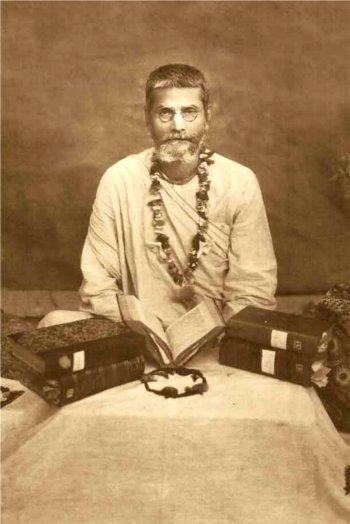
3. MAṆI-MAÑJARĪ
(First Installment)
The first issue of our Śrīla Gurudeva’s Śrī Bhāgavata-Patrikā (June 1955) included the first portion of a Hindi translation of Māyāvādera Jīvanī vā Vaiṣṇava-vijaya, a rigorously researched book on the history of Māyāvāda, written by Ācārya-keśarī Śrī Śrīmad Bhakti Prajñāna Keśava Gosvāmī Mahārāja.
In keeping with that tradition, here we include the first polished English translation of an extraordinary gem of a book, Maṇi-mañjari, by Śrī Nārāyaṇa Paṇḍitācārya, son of Śrī Trivikrama Paṇḍitācārya (to whom Śrī Madhvācārya granted Śrī Narasiṁha Nakha Stuti).
Below, Śrī Śrīmad Bhakti Prajñāna Keśava Gosvāmī Mahārāja provides a compelling recommendation of Maṇi-mañjari:
“…Trivikramācārya was a great scholar and ācārya of the Advaita-vādī sampradāya. His son, Nārāyaṇācārya, wrote the books Madhva Vijaya and Maṇi-mañjari. Trivikramācārya later became a prominent ācārya in the line of Madhva. Therefore, he was particularly well-acquainted with both philosophies. It was by hearing from him that Nārāyaṇācārya was able to convey a great deal about Śaṅkara and Madhva to the world. Therefore Śrī Nārāyaṇācārya’s books ought to be accepted by both Śaṅkara and Madhva lineages as very much authentic and important.” —Māyāvādera Jīvanī vā Vaiṣṇava-vijaya (page 96, Bengali edition).
Maṇi-mañjari is comprised of sweet, poetic summaries of Rāma-līlā and Kṛṣṇa-līla, followed by an in-depth refutal of Māyāvāda. This text is clearly composed in honour of Śrī Madhva and his incarnations as Hanuman and Bhīma, whereby he decimates the influences of the Asuras and Rākṣasas, establishing goodness and devotion to Bhagavān.
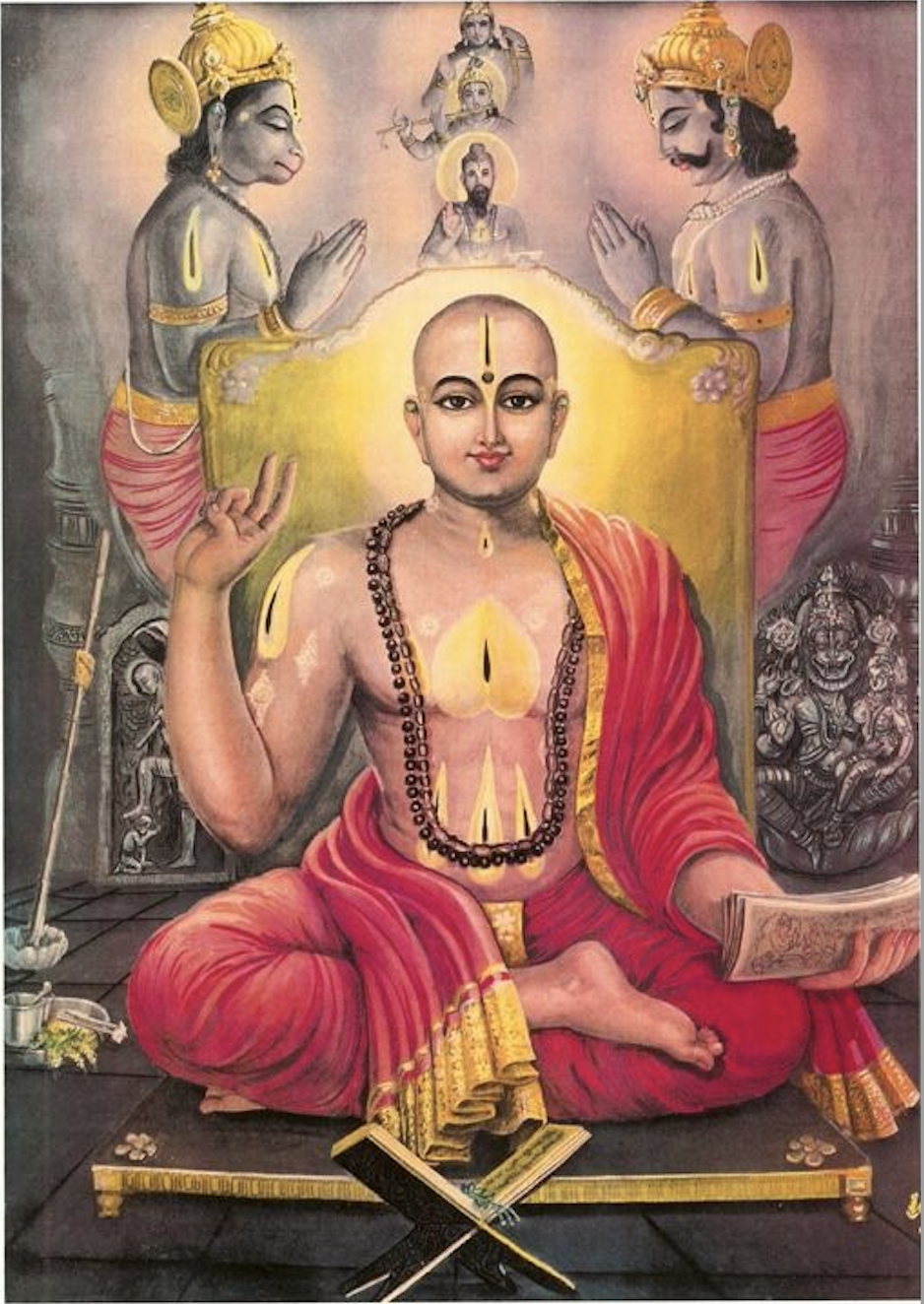
MAṆI-MAÑJARĪ
prathamaḥ sargaḥ
First Chapter
śrīmad-hanumad-bhīma-madhvāntargata-rāma-kṛṣṇa-veda-vyāsātmaka lakṣmī-hayagrīvāya namaḥ || 0 ||
Obeisance to Lakṣmī-Hayagrīva and to Rāma, Kṛṣṇa, and Veda-vyāsa as present within Śrī Madhva, the incarnation of Śrī Hanumān, Bhīma, and their source, the Pavana (Wind God) of Vaikuṇṭha
vande govindām-ānanda-jñāna-deham patim śriyaḥ
śrīmad-ānanda-tīrthārya-vallabham paramakṣaram (1)
I bow unto Govinda, whose body is cognizance and bliss, whose consort is Śrī (Lakṣmī). He is the beloved of the venerable Śrīmad Ānanda-tīrtha and is supreme and indestructible.
sasarjja bhagavānādau trīn-guṇān prakṛteḥ paraḥ
mahat-tattvaṁ tato viṣṇuḥ sṛṣṭavān brahmaṇas-tanum (2)
Bhagavān Viṣṇu first created the three modes of material nature. From these three guṇas, He created the mahat-tattva (“the totality”), the body of Brahmā.
mahat-tattvād-ahaṅkāraṁ sasarjja śiva-vigraham
daivān dehān manaḥ khāni khaṁ ca sa trividhāttataḥ (3)
From the mahat-tattva, He created Śiva’s body, the ahaṅkāra-tattva (“the principle of ego”). Then, from three types of ego, He created the demigods who preside the various senses, He also created the mind, the senses themselves, and the sky. [Bhagavān created mind and the presiding demigods from sāttvika-ahaṅkāra (a sense of identity rooted in the mode of goodness), the ten senses from rājasa-ahaṅkāra, and the five gross elements from tāmasa-ahaṅkāra.]
ākāśād asṛjad vāyuṁ vāyos tejo vyajījanat
tejasaḥ salilaṁ tasmāt pṛthivīm asṛjat vibhuḥ (4)
From that pre-existing sky, He created wind, and from the wind, He created fire, from fire, He created water, and from water, the Earth.
tataḥ kūṭastham asṛjat vidhiṁ brahmāṇḍa-vigraham
tasminstu bhagavān bhūyo bhuvanāni caturdaśa (5)
From the above twenty four tattvas, Bhagavan created Chaturmukha Brahma, who is the patron deity for the whole universe (Brahmanda), consisting of seven upper and seven lower worlds.
tāttvikān atha devān ko vairājaḥ puruṣo ’sṛjat
tathaiva paramān haṁsān sanakādīṁś ca yoginaḥ (6)
Thereafter, the Virāṭa Puruṣa, Brahmā, created the elemental demigods and paramahaṁsa-yogīs, like Sanaka and others.
asurān doṣa-rūpān apy avidyāṁ pāñca-parvaṇīm
varṇāśrama-viśeṣāṁś ca dharma-kḷptiṁ ca so ’sṛjat (7)
Then he created the Asuras, who are the embodiments of doṣa (imperfections), as well as five-fold Māyā, varṇāśrama (caste and station in life), and the rules of dharma.
marīcy atryādayaḥ putrā abhūvan parameṣṭhinaḥ
marīceḥ kaśyapo jajñe vāmanasya pitā baṭoḥ (8)
In sequence, Prajāpati’s sons, like Marīci, Atri, and others took birth. From Marīci was born the greatminded Kaśyapa, father of Vāmanadeva.
prajāḥ sisṛkṣur-vividhā avahat kaśyapo ditim
aditiṁ ca danuṁ kadruṁ kīkasāṁ vinatām api (9)
Desiring to produce progeny, Kaśyapa Ṛṣi married Diti, Aditi, Danu, Kadru, Kīkasā, and Vinatā.
dityāṁ tato ’bhavan daityā adityāñca surāḥ punaḥ
danau tu dānavāḥ kadrvāṁ nāgā nānā viṣolvaṇāḥ (10)
From Diti were born the Daityas, from Aditi the Devatās, from Danu the Dānavas, and from Kadru were born various species of venomous serpents.
See Archive for full first chapter (31 verses)…
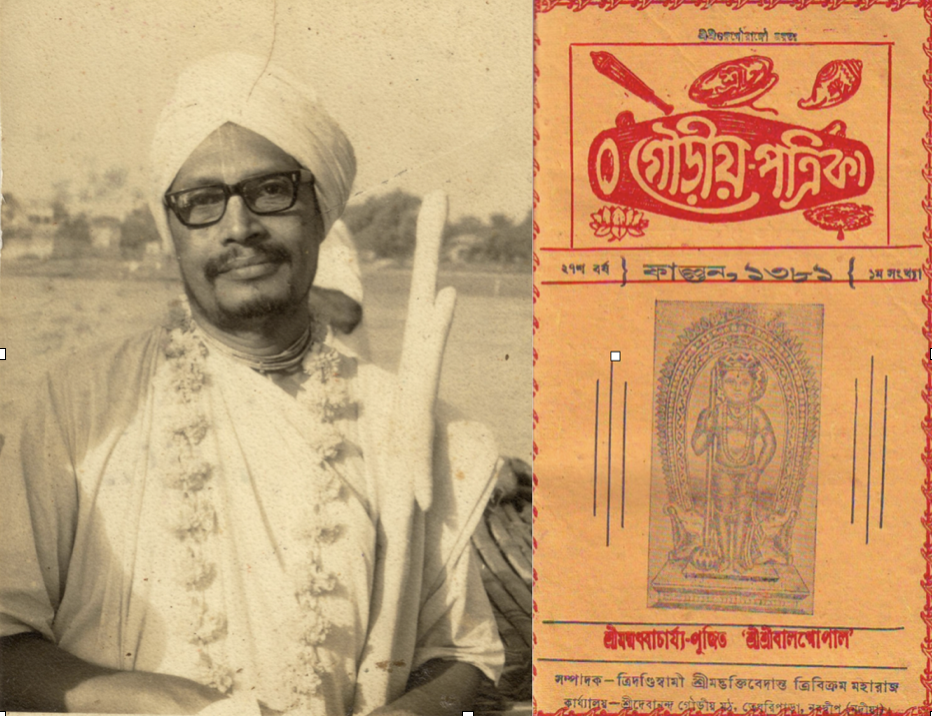
4. Excerpts from “Gauḍīya’s 27th Year”
By Śrī Śrīmad Bhaktivedānta Vāmana Gosvāmī Mahārāja
Presented in English for the first time
Glorification of Śrī Madhva in the Ṛg Veda
pradhārā madhvo āgriyo mahīr apo vigāhate | havir-haviḥṣṇu vandyaḥ |
asmabhyaminda vindrayur-madhvaḥ pabasva dhārayā | parjjanyo vṛṣṭimān iva || Ṛg Veda
[“First of those who traveled to Badarikāśrama on the invitation of Śrī Veda-vyāsa, venerated by his disciples who offered their souls or, in other words, worshipped him as the topmost guru, Śrīman Madhvācārya bathes in the flowing grand currents of Gaṅgā and other jñāna-nadīs (“knowledge rivers”). O ambition-bestowing incarnation of Mukhya Vāyu (The Chief Airs)! You connect Viṣṇu, who is full of supreme majesty, to the sujana (saintly personalities). In other words, you rouse their sambandha-jñāna. Your name is Śrī Madhva. Like a showering raincloud, shower the current of knowledge upon us, distribute it everywhere and purify us.]
Śrī Madhva glorifies Śrī Kṛṣṇa
devaki-nandana nanda-kumāra vṛndāvanāñcana gokula-candra |
kanda-phalāśana sundara-rūpa nandita-gokula vandita-pāda ||
[Son of Devaki (Yaśodā), Nanda’s little boy, O You who plays in Vṛndāvana! O delighter of Gokula! O You whose feet are worshipful! You eat kandmul and fruits, You have such a beautiful form, O moon of Gokula, son of Nanda!]
dāmodara-dūratarāntara vande dārita-pāraga-pāra parasmāt ||
[O Dāmodara! You are very difficult to attain for those who are not purehearted. But You are the refuge for liberated personalities who have crossed over the ocean of material existence. I bow to You!]
Dvādaśa Stotram (6.5, 5.8)
Śrī Madhvā’s birth-place
In the southwestern region of India, there is a very long range of mountains stretching from Gokarṇa-kṣetra to Kanyākumārī known as the Sahyādri, Malayagiri, or “Kola Parvata (Boar Mountain)”. This sacred region of the earth is known to many as Paraśurāma-kṣetra. It is divided into these three sections: Ādi, Madhya, and Anta-kerala. Of these, Ādi-kerala is divided into two provinces: northern Karnataka and southern Karnataka. Within southern Karnataka is Rajata-pīṭha-pura, and the other name for this place, its ancient name, is Uḍupī-kṣetra. Śrī Madhvācārya incarnated in Pājakā-kṣetra, which is very cloes to Uḍupī.
Śrīman Madhvācārya’s siddhānta and nine prameyas (principles)
According to Śrīman Madhvācārya’s philosophy, (1) Śrī Bhagavān Viṣṇu is topmost; (2) the world is true; (3) Īśvara, jīva, and jaḍa (the material world) have five mutual differences; (4) all the jīvas are the servants of Śrī Hari; (5) the jīvas have mutual differences of qualification; (6) the expression of the svarūpānugata-dharma (natural propensity) of the jīvas is mukti; (7) pure, unconditional bhakti alone is the means to reveal the dharma of the soul; (8) śabda (transcendental sound), anumāna (inference), and pratyakṣa (eye-witness testimony) are the three acceptable forms of pramāṇa (evidence); and (9) Śrī Hari is the object of all Vedic knowledge received via bona fide disciplic succession. These have been accepted as the nava-prameyas. Gauḍīya-Vedānta Keśarī (the lion of Gauḍīya Vedānta) Śrīla Baladeva Vidyābhūṣaṇa has also conveyed that Bhagavān Śrī Kṛṣṇa-Caitanya-candra accepted the madhvāmnāya (the Vedic teachings imparted by Śrī Madhva) and taught these same nine prameyas.
Why Śrīman Mahāprabhu accepted the Brahma-Mādhva-sampradāya
and established acintya-bhedābheda-siddhānta
Śrīla Śrīdhara Svāmī, in his Bhāvārtha-dīpikā, has written (12.13.19):
“śrī-bhāgavat-sampradāya-pravartaka-rūpeṇa bhagavad-dhyāna-lakṣaṇaṁ maṅgalam-ācarati,—kasmai brahmaṇe |”
It is clearly understood from this that there is a sampradāya called the Brahma-sampradāya that has existed since the beginning of Creation. In that sampradāya, bhagavad-dharma (the Dharma taught by Bhagavān Himself), which is the pristine message of the Vedas and Saṁhitās, has been preserved and received in an unbroken succession of gurus and disciples. The Śrī Brahma-sampradāya represents the guru-praṇālī (succession of teachers) for the servants of Śrī Kṛṣṇa-Caitanya. The acceptance of the saccidānanda-vigraha (the Lord’s transcendental form) that exists in Śrī Madhva’s philosophy is the basis of acintya-bhedābheda and is why Śrīman Mahāprabhu accepted the Madhva-sampradāya. Śrī Caitanya Mahāprabhu, who is the Absolute Truth (para-tattva) Himself, filled in the lackings of all those [Vaiṣṇava] philosophies by the power of His omniscience. He refined and completed Śrī Madhva’s tenet of saccidānanda nitya-vigraha (Bhagavān’s eternal transcendental form), Śrī Rāmānuja’s śakti-siddhānta (conclusions regarding Bhagavān’s energies), Śrī Viṣṇusvāmī’s śuddhādvaita-siddhānta (pure monism), and Śrī Nimbāditya’s cintya-dvaitādvaita-siddhānta (philosophy of conceivable oneness and difference). Thus He mercifully offered to the world the extremely refined and scientific philosophy of acintya-bhedābheda (inconceivable oneness and difference). It is because Śrīman Madhvācārya established bheda (ontological difference) as being eternal that the philosophy of acintya-bhedābheda has been properly consolidated.
Singing the glories of Bhakta-Bhagavān via the conjunction of
Śrī Kola Parvata, Vraja-pattana, and Koladvīpa
We have previously discussed that Śrīman Madhvācārya-pāda appeared in Uḍupī, which is not far from the sacred land of Paraśurāma-kṣetra, which is surrounded by Sahyādri, or Kola Parvata. It is mentioned in various śāstras that the world-sanctifying four Vaiṣṇava sampradāyas—Śrī, Brahma, Rudra, and Sanaka—will bestow endless welfare upon the world in this age of Kali. Svayaṁ Bhagavān Śrī Kṛṣṇa-Caitanya Mahāprabhu accepted the truths they preached, especially the conceptions of Śrī Madhva, and established “acintya-bhedābheda-siddhānta” as the whole and complete form [of Vaiṣṇavism]. That is why, in order to honor them, the lion-like ācārya of the Śrī Rūpānuga Gauḍīya-Vaiṣṇavas, jagad-guru oṁ viṣṇupāda Śrīmad Bhaktisiddhānta Sarasvatī Prabhupāda, established in Śrīdhāma Māyāpura, at Vraja-pattana (the house of Śrī Candraśekhara Ācārya), the four founding ācāryas of the sampradāyas along with Śrī Śrī Guru-Gaurāṅga-Gāndharvikā-Giridhārī-jīu in an immense temple that features twenty-nine spires. My own supremely venerable śrī guru-pādapadma, oṁ viṣṇupāda Śrīmad Bhakti Prajñāna Keśava Gosvāmī Mahārāja, followed the example of his cherished master and established a sky-piercing temple with nine domes in this Koladvīpa (Girirāja Śrī Govardhana), a portion of Śrī Navadvīpa-dhāma, which is itself the sacred seat of navadhā-bhakti. He installed Śrī Śrī Guru-Gaurāṅga Rādhā-Vinoda-bihārī-jīu along with the sampradāya originators, namely Śrī Lakṣmī, Brahmā, Catuḥsana, and Rudra, as well as the four ācāryas—Śrī Madhvācārya, Śrī Rāmānujācārya, Śrī Nimbādityācārya, and Śrī Viṣṇusvāmī—in four designated corners [of the temple domes], thereby promoting their glory.
A matter to take special notice of is that the predecessor ācārya of the Gauḍīya-Vaiṣṇava-sampradāya, Śrīmad Ānanda-tīrtha Madhva-muni, came from ‘Kola Parvata to Vraja-pattana, and from there has again appeared and presides within Koladvīpa, Kūliyā-pahāḍa (the mountain of Kūliyā), which is non-different from Govardhanādri. Every year, the Gauḍīya-Vaiṣṇavas who are thoroughly bathed in the current of Śrī Rūpānuga-Gaura-Vāṇī-Vinoda observe Śrīman Madhvācārya’s auspicious Vijayotsava (appearance festival) and worship the day of his auspicous appearance. Finally, we sing the praises of the āśraya and viṣaya Śrī Bhagavān under the guidance of the Gauḍīya guru and thereby conclude our composition:
adhika-bandhaṁ randhaya bodhāc-chindhi pidhānaṁ bandhuram addhā |
keśava keśava śāsaka vande pāśadharārccita śura-vareśa ||
[O Keśava! Chastiser! Supreme Lord of the Śūris (the demigods or the Yādavas)! I bow to You. Kindly destroy our formidable bondage of material existence by bestowing prajñāna (realized knowledge) and rend asunder this spectacular obscurement that is avidyā (non-knowledge).]
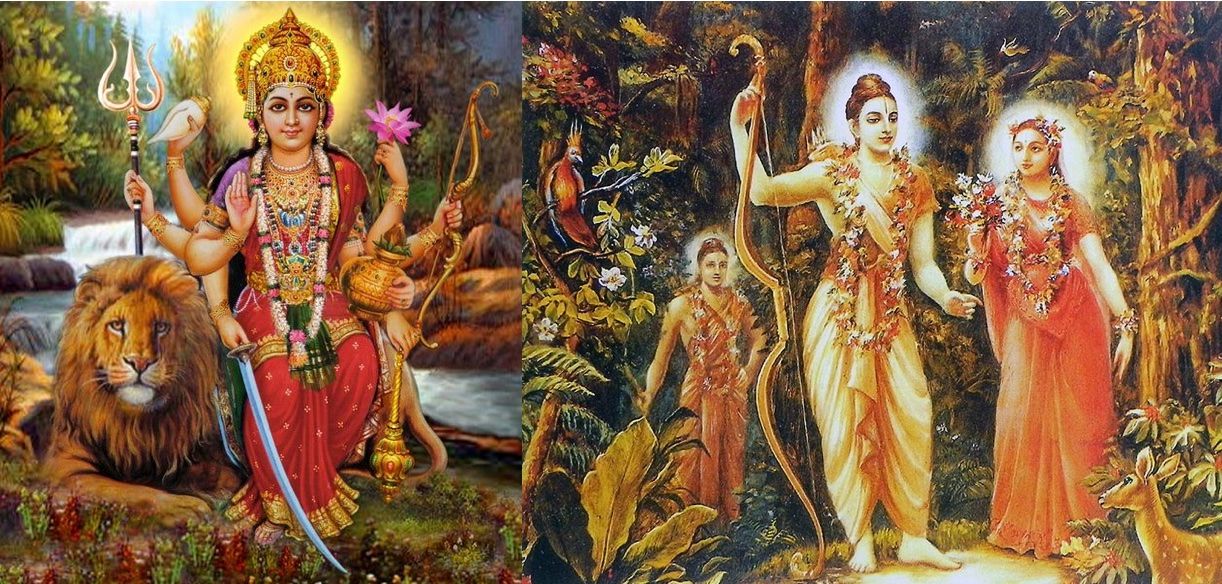
5. Śrī Rāmacandra and Durgā-pūjā
By Śrī Śrīmad Bhaktivedānta Nārāyaṇa Gosvāmī Mahārāja
Traditionally, the first nine days of Caitra’s (March-April) śukla-pakṣa [bright fortnight] is the time to worship Durgā; however, modern day Durgā-pūjā is celebrated in Bengal with great fanfare from the seventh day of the bright fortnight to the ninth, during the month of Āśvina (September-October). Nowadays, this modern pūjā trend from Bengal has been popularized throughout India. Many people believe: “Śrī Rāmacandra worshipped Mahā-māyā Durgā in the autumn season to vanquish Rāvaṇa and, by her grace, killed Rāvaṇa on the tenth day [of that period]. This is why the śukla daśamī [“bright tenth”] of Āśvina is called Vijayā Daśamī.” But their belief is completely mistaken, as there is no mention of it in any authoritative scripture like the original Rāmāyaṇa by Vālmīki, Śrīmad Bhāgavatam or Padma-purāṇa. Popularization of said belief originates from a rather recent and concocted Upapurāṇa, the Kālkā Purāṇa, and the fabricated Bengali Rāmāyaṇa of a bigoted Śākta [Goddess-worshipper] named Kīrttivāsa. The Vālmīki Rāmāyaṇa proves the above-mentioned notion to be completely false.
Knowing Śrī Rāmacandra to be worthy, and on the insistence of the citizens, Mahārāja Daśaratha makes a declaration about making Him the crown prince:
caitraḥ śrīmānathaṁ māsaḥ puṇya puṣpita kānanaḥ |
yauvarājyāya rāmasya sarvamevopakalpatām ||
śva eva puṣpo bhavitā śvo’bhiṣecyastu me sutaḥ || (Ayodhyā Kāṇḍa, Sarga 3-4)
In this superb and holy month of Caitra, when the forests and gardens are blooming with beautiful flowers and becoming utterly enchanting, please prepare for the coronation of Śrī Rāmacandra as crown prince. Tomorrow, under the constellation Puṣyā, He will be crowned heir to the throne.
However, something else was destined to happen. The next day Rāma is exiled to the forest for fourteen years, and He goes to the forest. Bharata goes to the forest to bring Him back, but Rāma’s determination and irrefutable arguments compel him to return to Ayodhyā, carrying Rāma’s sandals on his head. However, as he was poised to return, he also took a harsh vow: “Oh Raghu-nandana! I will keep managing the entire kingdom, offering all my kingly duties at your shoes, but the day that fourteen years are over, if I do not see you in Ayodhyā, I will burn myself in a fire and become ash.”
As such, it was certain that Rāma was to return to Ayodhyā the very day that fourteen years were complete. The day He was to be crowned heir was the day His exile to the forest started. That is, He was exiled on the puṣyā-nakṣatra day of the bright fortnight during the month of Caitra. So it was that He killed Rāvaṇa and returned to Ayodhya in the month of Caitra—there are no two ways about it. In the Yudha-kāṇḍa [“Battle Section”] it is further clarified that the battle was finished on fourteenth day of the dark fortnight of Caitra. The end of the battle means the killing of Rāvaṇa. After killing Rāvaṇa, Śrī Rāmacandra crowned Vibhiṣaṇa on the throne of Laṅkā and returned to Ayodhyā during the puṣyā nakṣatra of Caitra’s bright fortnight. Hence, Rāvaṇa was killed in month of Caitra and not in Āśvina. Secondly, there is no mention of the worship of Durga by Śrī Rāma in the Vālmīki Rāmāyaṇa. Therefore, Śrī Rāmacandra’s worship of Devī during the month of Āśvina and the killing of Rāvaṇa on the śuklā daśamī day of Āśvina is completely false, unsubstantiated, and concocted. This is the contribution of śākta poet Kṛtivāsa.
Kṛtivāsa was a leading śākta poet. To preach śākta philosophy to the susceptible and ignorant masses, he took the story of Rāma, for which they had utmost regard, cast it in the mould of his own contrived notions, and placed it before them. He had the omnipotent Bhagavān Śrī Rāma worship His own threefold illusory energy—Durgā-devī or, in other words, attempted to establish the supremacy of Durgā over even Śrī Rāmacandra.
Mahā-māyā—Durgā is Bhagavān’s external potency. Her job is to delude the living entities and trap them in the prison of material existence. Her job is not appealing to Bhagavān—she herself realizes this fact. And for this reason, she is shy to come before Bhagavān.
vilajjamānayā yasya sthātumīkṣāpathe’muyā|
vimohitā vikatthānte mamāham-iti durdhiyaḥ || Śrīmad Bhāgavatam, 2.5.13
Those bewildered by she who is ashamed to stand in the path of His gaze blather like idiots about what is theirs and who they are.
Hence, how is it possible for the personified potency who feels shy to even face the Lord to get worshipped by Him? More specifically, can a maidservant accept the worship of her master—a wife the worship of her husband? So, the idea of Śrī Rāma performing Durgā-pūjā is not even logical, what to speak of substantiated.
History of modern Durgā-pūjā
The actual time for Durgā worship is in the month of Caitra. However, modern-day Durga-pūjā happens in Āśvina, a trend that originated from Bengal and spread all over India. There is a story behind this modern-day Durgā-pūjā: During the rule of the Mughal Empire, King Kaṁsa-Nārāyaṇa, who was king of Tahirpur, part of the Rājaśāhī district of Bengal, was Subedar and Diwan. At one time, he invited all the leading smārta priests and asked their permission to organize the performance of a grand fire sacrifice.
At that time, Śrī Rameśa Śāstrī of Vāsudeva-pura, which is close to Nāṭor, was the royal priest. He was considered to be the leading scholar of Bengal and Bihar at that time. He told to the king that there were four yajñās that are considered mahā-yajñās: “Viśvajita [world conquest sacrifice], Rājasuya [imperial sacrifice], Aśvamedha [horse sacrifice] and Gomedha [cow sacrifice]. Only a king of the whole planet is eligible to perform the Viśvajita and Rājasuya, and the Aśvamedha and Gomedha are prohibited in Kali-yuga. Secondly, only kṣatriya kings are qualified to perform these sacrifices. You are a brāhmaṇa. Therefore, it is not your duty to conduct these yajñās. In ancient times, King Suratha worshipped Durgā-devī and attained the result he so cherished. Hence, you should also worship Durgā-devī in this autumn season. With this, your desires of attaining the heavenly planets, etc. will be fulfilled.”
Accordingly, in the year 1580, the king spent a great amount of wealth and performed an untimely Durgā-pūjā. Instead of Caitra, it was during the month of Āśvina. That is why it is also called: “Akāla Bodhana – Untimely Awakening”. Gradually, this new form of Durgā-pūjā spread all over Bengal and then all over India. Rameśa Śāstrī was the initial proponent of this modern-day Durgā-pūjā; it cannot be considered authentic or in accordance with scriptural injunctions.
—translated from "The Mystery of Śakti-pūjā", Śrī Bhagavata Patrikā, Year–3, Issue–5 (1957-1958), pages 108-112.
